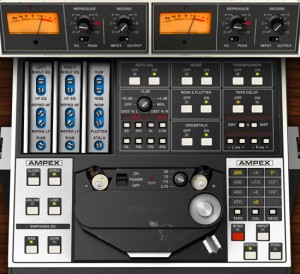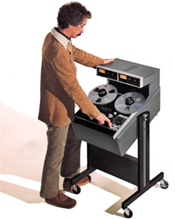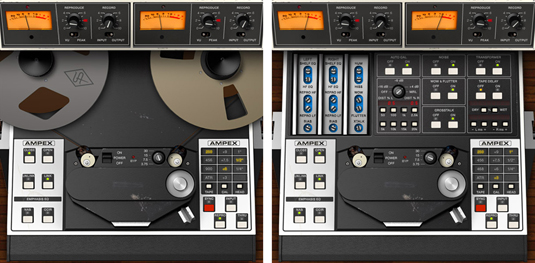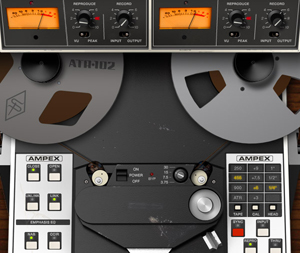Review: Universal Audio UAD Ampex ATR-102 Plug-in
If you make your living recording and mixing music, no matter how much you may love working with tape, the budgets for many a project will simply not allow you to use it – either because of the cost of the tape itself, or the cost imposed by the workflow that tape demands.
Universal Audio created their UAD Ampex ATR-102 plug-in for the UAD platform to address this modern-day problem. This plug-in runs on a UAD-2 card, and can be used in VST, AU or RTAS plug-in formats.
The UAD ATR-102 is modeled after the famous 2-track Ampex ATR-102 tape deck that’s been in constant use in studios all over the world since it was first introduced in 1976.
According to Universal Audio’s marketing department, the ATR-102 is “considered by many engineers to be the best sounding tape machine for final mix down.” And the resale price of these specific machines would tend to bear this claim out. Last time I checked, a refurbished ATR-102 was selling for over $10,000!!
If it Looks Like an ATR-102 and Sounds Like an ATR-102…
Universal Audio has (again) done a fabulous job of creating a convincing visual replica. Clearly this is a selling point on the plug-in emulations market, and I am open to the suggestion that the authentic looking graphics may well help fool my ears into thinking that that which looks like a tape machine also sounds like one.
And yet, I think one of the appeals of plug-in emulators is that they present us with a familiar set of parameters. The learning curve feels faster because our brains already have an idea of how something should work, and we – the users – can anticipate the results, even to the point of convincing ourselves that something sounds like the real thing when it doesn’t. It at least kind of acts like the real thing, right?
With that in mind, I’d like to believe that if the UAD ATR-102 were a 100 miles away from sounding like the hardware, I could tell the difference. The moment that convinced me that this plug-in is, in fact, shockingly close to the hardware, was when I changed the head stack setting from 1” to 1/2”. I’ve never used a 1” ATR-102 before so I don’t have a point of reference for it. I have, however, spent plenty of time with the 1/2” ATR-102. The minute I engaged the 1/2” head stack setting on this the plug-in, my jaw dropped. I was hearing that familiar smoothness with a slight roll-off on the low, low end, that has served so many, so well.
I’d go as far as to say that this plug-in sounds about as close to the real thing as any two Ampex 102’s are likely to sound to each other after 40 years of modifications, repairs and day to day usage.
Features/Functions (But Wait! There’s More…)
As with UA’s Studer A800 plug-in, the UAD ATR-102 can operate in an automatic calibration mode, leaving the user to select between 4 tape speeds (30ips, 15ips, 7.5 ips, 3.75 ips), 4 tape formulations per tape speed, 4 record levels per formulation (+3,+6,+7.5,+9), 3 head stack widths (1/4”, 1/2” and 1”), 3 input options (repro head, sync head, input) and 2 pre-emphasis EQ settings (AES or, NAB & CCIR).
If that’s not enough, and you prefer not to use the plug-in’s auto-calibration feature, you can adjust all parameters that exist on a real world machine (well… almost all, no azimuth screw – what’s up with that, UA?:-)). When you want a little less over-biasing than the auto-cal provides, just turn a virtual screw. You can adjust record, sync and playback equalizations (hi and low) as well.
AND, if you are a sucker for 10khz tones like I am, then you’ll revel in this plug-ins’ calibration mode which provides you with the ability to do an alignment from scratch using the tones generated from the UAD ATR-102’s built-in oscillator function. (I expect someone to find a cool, unintended use for this.)
So thoroughly does the UAD ATR-102 break out the functions used in the calibration process, that even if this thing didn’t sound as good as it does, it would still have a future as a teaching tool at recording schools the world over. Institutes of higher learning may not have the money to buy a fleet of vintage ATR-102’s, but they can certainly afford this plug-in and a few UAD-2 cards.

Features include adjustable Wow, Flutter, Hiss, Hum, Crosstalk, and (L/R) Tape Delay. Click to enlarge.
And yet, that’s not all…
With this plug-in you get a complete set of Ginsu knives AND Universal Audio has thrown in a mode allowing the UAD ATR-102 to be used as a tape delay so you can enjoy the sound of your alignment with the delay times of your choice.
In addition to the functions you want from your analog tape deck, Universal Audio has also included features that electrical engineers have tried very hard to eliminate from their analog designs. Want more cross talk? You got it! (This is really cool) How ‘bout some wow? Not into wow? Maybe some flutter? Ok, just tape hiss? NO PROBLEM, it’s included, unless you turn it off.
And, in response to popular demand and common modification, the UAD ATR-102 now includes the transformerless mod, should you choose to be as pristine as possible in your plug-in’s signal path.
Seriously, there are a plethora of screws to turn and buttons to press with this plug-in. With some software, I would say that too many options is as frustrating as too few. It can be confusing and annoying to search for the one parameter you want to tweak among the many you have no use for. The familiarity of the interface avoids this problem for me, as I’m sure it will for many potential customers. Even if you don’t understand what half of the stuff does, however, UA’s eminently useful presets and auto-calibration features will have you up and running quickly.
In Use
For the record, I have a long-standing relationship with UA. As a gear-nerd reviewer I have a vested interest in saying nice things about their software. But saying nice things and actually using a product every day to mix records are two different things. If my work doesn’t make my clients happy they let me know, and my reputation potentially suffers. So I am extremely critical in my evaluation of new tools for my own arsenal… and this one has more than made the cut.
In fact, I’ve put the ATR-102 plug-in on every mix I’ve done on my home system since it was released (that’s about 4 months of mixes), including Eytan and the Embassy‘s new single “Everything Changes,” P.T. Walkey‘s forthcoming record Thriller, and mixes on an upcoming solo release by James Iha – formerly of The Smashing Pumpkins and currently of A Perfect Circle.
Primarily, I’ve just been using the ATR-102 plug-in as the last insert on my mix bus. I’ve tried it on bass and vocals as well as on piano – all with satisfying results. I’ve played with it as a parallel bus processor too, but the biggest impediment to using and overusing the UAD ATR-102 is the fact that it’s a processor hog with substantial latency. If you are working in Pro Tools as I am, then you can’t run many of these both as inserts and on parallel busses if you are also working at lower sample rates. The maximum delay compensation of Pro Tools 9 is fairly low relative to what this plug-in requires. [Ed. note: According to UA, delay compensation improvements in Pro Tools 10 greatly benefit UAD users.]
As a mix down processor I’ve explored most of the tape types, speeds and head stacks. I thought I’d use the 30 ips setting more, but I almost always end up at 15 ips, often using the UAD ATR-102’s default starting alignment: 456 at 15ips on 1” tape at +6 nwB/m. It makes me wonder whether after all these years I should have been printing to 15 ips more often, even if you can’t turn the hiss off of a 1/2” machine like you can on a plug-in.
The transformerless option is a particularly nice inclusion on this piece given how much it affects the low end. Take it out when you really want to hear maximum bass at all frequencies, and keep it in when you want to move the bass from your bowels to your solar plexus.
The processor intensity and latency make me less likely to use the UAD ATR-102 as a tape delay. I have many other delay options, and while this one is really cool and sounds great, it’s not always worth the cost in latency and processing. With that said, because of its remarkable breadth of parameters, you can make some pretty unique and realistic sounding delay effects with this plug-in.
I recently enjoyed using the wow, flutter, and cross talk settings to create a “tape being eaten” effect on a mix for James Iha that I’ve never before been able to accomplish in the box.
Constructive Criticism
Other than the processor usage and latency, the only other bee in my bonnet with the UAD ATR-102, which is my critique of UA’s design philosophy in general, is that there are no numeric values given for individual parameters. With so much packed into the graphics of this plug-in, that would be a welcome addition.
I get why UA avoids numbers on their emulations: those numbers aren’t there in the real world, so why put them on a plug-in? And not having those numbers also forces the more OCD among us to adjust by ear rather than numeric value.
But, some of the mappings from mouse to knob/screw on this plug-in just aren’t comfortable, and this makes the lack of numeric values all the more frustrating. I can’t tell if some of the things I have been confused by are issues of plug-in resolution or personal dexterity. For example, after being thwarted by mousing on the Playback Output knob, I turned to my MC Mix control surface to make adjustments only to notice the displayed playback output levels moving in non-linear increments, going from 0 to -.33db to -.76db to -1.24 db.
You just can’t see the screws well enough to control them in subtle ways, or even tell if that degree of resolution is supposed to be there. If there were numeric values, this would be a moot point. And it would be one way to allow the user to quickly compare settings.
If UA doesn’t want to start showing parameter values per se, I would love to see this plug-in (and their Studer 800 as well) given some kind of memory settings so we could at least easily a/b (or in my case a/b/c/d) things while making adjustments. Being able to quickly compare alignments would be a real help given that the differences between settings on a tape machine are often quite subtle and are therefore easy to quickly forget.
To conclude, after using this product almost daily since its release, it got me thinking that the end of a certain analog fetishism seems closer than ever before. Given how close this sounds to the original, I just can’t imagine shelling out $10k for the real McCoy.
While I love the fact that each piece of vintage gear is unique its own way, supplies the user with its sonic fingerprint and has no latency, I will not miss paying for repairs, downtime, or tape. And I certainly won’t miss having to do alignments or worry about getting into the nicer studio with the tape machine just to do a mix recall.
Universal Audio’s Ampex ATR-102 Mastering Tape Recorder Plug-In runs on the UAD Powered Plug-Ins platform and sells for $349 on the UA Webstore. Click for more details.
Geoff Sanoff is a GRAMMY-winning NYC-based producer/engineer and musician who’s worked with Fountains of Wayne, School of Seven Bells, Obits, Nada Surf, Aaron Neville, Sarah Brightman and the Sheepdogs (among many others). Contact Geoff through Just Managing.









